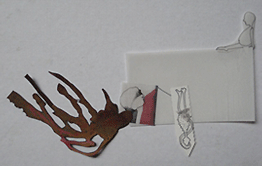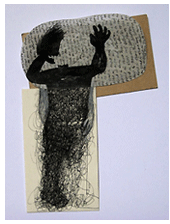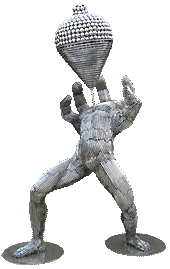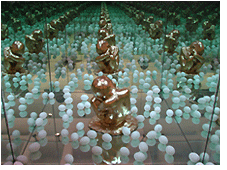- Prelude
- Guest Editor’s Column
- Hard Talk
- Digital Art
- The Write Stuff
- The Art of the Shakers : Shaker Furniture
- New Media
- In the News
- GenNext
- Report
- Artist Index and Statistics
- Market Insight
- Auction Reports
- The month that was
- Mumbai Artsighting
- Musings from Chennai
- Delhi Dias
- Deccan Odyssey
- Art Bengaluru
- In between – from Vadodara
- North-East Opsis
- A Tryst with Art in Madhya Pradesh
- Strands of Social Semiotics
- Transcending Popular
- Art of the Land & Land in Art (part I)
- Through The Patina
- Earth
- Go See India
- Dali's Elephant
- Malleable Memory
- Creative Impulse
- Different hues of Aakriti
- Bonhams : Fine Writing Instruments New York
ART news & views
In between – from Vadodara
Volume: 2 Issue No: 7 Month: 8 Year: 2010
 Preksha Tater's works are spontaneous scribbling dictated by the need to verbalize/visualize her subconscious. She is comfortable with drawings, colleges, cutouts, which are done in small formats in size of visiting cards. These drawings are done randomly and have a playful spontaneity in them. Though her works doesn't have an ambitious aspect, its arrangement together in random permutations and combinations done intuitively creates a visuality which attracts attention.
Preksha Tater's works are spontaneous scribbling dictated by the need to verbalize/visualize her subconscious. She is comfortable with drawings, colleges, cutouts, which are done in small formats in size of visiting cards. These drawings are done randomly and have a playful spontaneity in them. Though her works doesn't have an ambitious aspect, its arrangement together in random permutations and combinations done intuitively creates a visuality which attracts attention.  She doesn't emphasize on the thematic content but meanings meander through the images almost like doodles. This allows the chance for a narrative to build up. Interestingly, there is no emphasis on linear or progressive reading of her work rather its all chance that is emphasized. It is chance that builds up something; some kind of an atmospheric ambience and a psychological topography where the subconscious is let free in a particular moment. The images are absurd and at the same time recognizable and abstract. She doesn't self consciously select her images and always emphasize on the process which leads to the recognizable forms in her works. Her works are more about formal and visual pleasure. This dependence on automatism and process reduces the physical involvement in the form of labor. The work process involves a gradual realization from simple recognizable forms or hues of colours which slowly builds up in accordance to her instinctive needs and formal pleasures.
She doesn't emphasize on the thematic content but meanings meander through the images almost like doodles. This allows the chance for a narrative to build up. Interestingly, there is no emphasis on linear or progressive reading of her work rather its all chance that is emphasized. It is chance that builds up something; some kind of an atmospheric ambience and a psychological topography where the subconscious is let free in a particular moment. The images are absurd and at the same time recognizable and abstract. She doesn't self consciously select her images and always emphasize on the process which leads to the recognizable forms in her works. Her works are more about formal and visual pleasure. This dependence on automatism and process reduces the physical involvement in the form of labor. The work process involves a gradual realization from simple recognizable forms or hues of colours which slowly builds up in accordance to her instinctive needs and formal pleasures.
 Ketan Amin's sculptures have a consistent recurrence of images. He feels there Is no need to render the whole body rather prefers a strange combination of hands with feet, legs or torso. This gives his work a surreal look. Though he uses classical bodies from Renaissance / Greek sculptures which are of an idealistic type they have a theatrical agility of baroque realism. He prefers talking about varied issues from global warming to contemporary politics by using the same images repeated over and over again almost to the point of exhaustion. This modernist claim for consistency of putting meanings from above leads to the artist's intentional fallacy and meanings gets locked only in the artist's dictionary. His skilful rendering of the body and technical expertise stands out strikingly separate in his works. One can also read how high art images are adopted in popular vocabularies. His sculptures can be seen as 'vernacularisation' of classical art forms. The peculiar aspect of this vernacularisation (for example the sign boards in India) is the unproblematic use of forms from any historic context and placing in a entirely different unrelated new situation. Can this be seen as a way to negotiate with the high and classical?
Ketan Amin's sculptures have a consistent recurrence of images. He feels there Is no need to render the whole body rather prefers a strange combination of hands with feet, legs or torso. This gives his work a surreal look. Though he uses classical bodies from Renaissance / Greek sculptures which are of an idealistic type they have a theatrical agility of baroque realism. He prefers talking about varied issues from global warming to contemporary politics by using the same images repeated over and over again almost to the point of exhaustion. This modernist claim for consistency of putting meanings from above leads to the artist's intentional fallacy and meanings gets locked only in the artist's dictionary. His skilful rendering of the body and technical expertise stands out strikingly separate in his works. One can also read how high art images are adopted in popular vocabularies. His sculptures can be seen as 'vernacularisation' of classical art forms. The peculiar aspect of this vernacularisation (for example the sign boards in India) is the unproblematic use of forms from any historic context and placing in a entirely different unrelated new situation. Can this be seen as a way to negotiate with the high and classical?
 Mansoor Ali explores and works on a wide range of images and materials. His sculptures and installations are conceptually framed with a preplanned and premeditated intension. His primary emphasis has been on the question of identity. This emphasis on the subject's identity formation and its conflict with varied social forces makes him question the system more from a self reflexive and experiential position. His major critique is also on the political and the bureaucratic class of the country. The craze for power and the hypocrisies of policy decision is a major theme of his work. Taking the obvious example of chair as a seat of power he tries to see the ironical meanings attached like comfort and so forth. There is no escape from the great game of power. Every time there are dialogues for bringing about peace, they are always broken and it traps humanity in vicious cycle of violence and uncertainty. The players change but the game remains the same. The minorities are always at the edge, within fragile walls of hope. Their identity is often at flux and is constantly monitored and threatened.
Mansoor Ali explores and works on a wide range of images and materials. His sculptures and installations are conceptually framed with a preplanned and premeditated intension. His primary emphasis has been on the question of identity. This emphasis on the subject's identity formation and its conflict with varied social forces makes him question the system more from a self reflexive and experiential position. His major critique is also on the political and the bureaucratic class of the country. The craze for power and the hypocrisies of policy decision is a major theme of his work. Taking the obvious example of chair as a seat of power he tries to see the ironical meanings attached like comfort and so forth. There is no escape from the great game of power. Every time there are dialogues for bringing about peace, they are always broken and it traps humanity in vicious cycle of violence and uncertainty. The players change but the game remains the same. The minorities are always at the edge, within fragile walls of hope. Their identity is often at flux and is constantly monitored and threatened.
 His works “I wanna stenciled God die”, ”Black Friday”,” I wasn't asked to be born”, “I don't know the blood group”, “dance of democracy” are all about the fragility of ones existence at the margin of society. The symbols like child's image the eggs, chair, cracks and even blood are important elements for his work in its exploration of a world of fragile borders of violence and faith. The fragmented self is symbolically shown with the fissured cracks. The decentered peripheral “other” is always made to sit dormant and voiceless by large majoritarian forces of the society which also finds a reflection in his works. His present work titled “Jugad” is a commentary on the ugly nature of history which washes its hands in blood. Everything starts and ends in bloodshed of the weak victims and the victory of the totalitarian rich forces. His chairs are generally made dysfunctional but have an aesthetic richness its authority and its presence is immense with surreal dream of coming up in equilibrium by standing (posturing) on the edge which is the condition of any minority in any country. This work talks universally about not only particular country's communal atmosphere but for the whole world.
His works “I wanna stenciled God die”, ”Black Friday”,” I wasn't asked to be born”, “I don't know the blood group”, “dance of democracy” are all about the fragility of ones existence at the margin of society. The symbols like child's image the eggs, chair, cracks and even blood are important elements for his work in its exploration of a world of fragile borders of violence and faith. The fragmented self is symbolically shown with the fissured cracks. The decentered peripheral “other” is always made to sit dormant and voiceless by large majoritarian forces of the society which also finds a reflection in his works. His present work titled “Jugad” is a commentary on the ugly nature of history which washes its hands in blood. Everything starts and ends in bloodshed of the weak victims and the victory of the totalitarian rich forces. His chairs are generally made dysfunctional but have an aesthetic richness its authority and its presence is immense with surreal dream of coming up in equilibrium by standing (posturing) on the edge which is the condition of any minority in any country. This work talks universally about not only particular country's communal atmosphere but for the whole world.
- Rollie Mukherjee
Artist, Art Critic